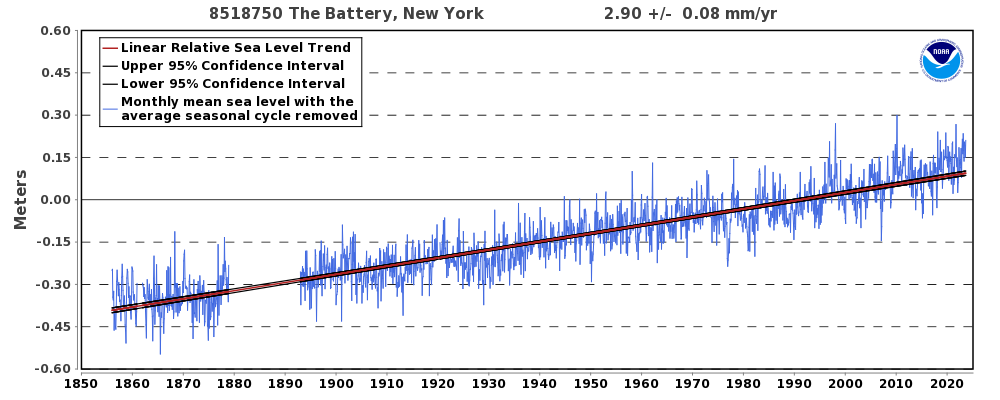The New York Times (NYT) recently posted an article, “A Climate Change Success Story? Look at Hoboken,” claiming Hoboken, New Jersey is doing a good job handling climate change related flooding. Although it is true that Hoboken has historically been prone to flooding it has nothing to do with climate change. Much of Hoboken is located in a flood plain. As a result designing infrastructure to handle flooding is a good idea, even if human-caused climate change is not responsible for the flooding.
The article starts off by admitting that Hoboken was “once a marshy outcropping that the Lenape inhabited only seasonally,” on the Hudson River, and “three-quarters of it occupies a flood plain.” The NYT even calls the city “a water magnet” before claiming that scientists say it might be underwater by 2100 due to rising seas.
This is an important admission, because flood plains are, obviously, prone to flooding regardless of climate change. The city’s usable land is just over one square mile, and sits at just 23 feet of elevation.
As discussed in many Climate Realism stories about various towns and cities on floodplains, including here, here, and here, for example, the UN Intergovernmental Panel on Climate Change reports only “low confidence” that climate change is having any impact on flooding, despite contributing to a bit more precipitation in the mid-latitudes of the northern hemisphere.
Hoboken is across the river from the National Oceanic and Atmospheric Administration Tides and Currents sea level monitoring station in The Battery, New York, which shows relatively stable sea level rise since the 1850s. If this trend continues, Hoboken would probably have sea water lapping at their toes in more like two thousand years than by 2100, as NYT claims. (See figure below)

This data suggests no apparent increase in the rate of local sea level rise due to purported human climate change. Of course, sea level rise is just one possible factor in measured sea level rise, another factor, land subsidence (sinking) is also to blame, especially in nearby New York City.
Cities are prone to bad floods even if they aren’t already in a historic flood plain – the increase of impermeable surfaces like concrete and asphalt makes it difficult for water from heavy rains to soak into the ground, instead pooling on the surface and causing damage to buildings. The city council in Hoboken seems to be aware of this factor, fortunately, and much of the NYT article focuses on the infrastructure plans that the city has implemented over the years to improve water handling.
The NYT points out that old, aging “sewers like New York’s, which process both waste and storm water, were built to handle only a couple of inches of rain per hour.” They neglected to mention that undoubtedly the amount of waste has also increased, as the city’s population increased substantially over the decades.
Hoboken increased the capacity of their sewer systems, and added cisterns and basins to hold even more water underneath new parks and playgrounds. They also fixed power lines and improved building flood protection. All of these are good ideas for a city that has, due to its location, historically been prone to flooding, regardless of climate change. Homeowners who got their homes flooded may need to seek Affordable Remediation & Emergency Services to help with the cleanup and repairs.
The New York Times would do well to remove the climate change alarmist claims from this article, and instead focus on the reality of improving weather resilience to a city that badly needed it because hundreds of years ago, someone decided a patch of land that was mostly riverside swamp was a good place to set up a city.





















NYT is famous for denying lots of events and facts and supplanting them with falsehoods! They denied the holocaust and other atrocities! They are hardly a source for reliable information if it doesn’t fit their narrative! Like most newspapers they have a slant and constantly make headlines without much evidence to support their headlines! Need to make sure that multiple sources are investigated when they use the buzzwords like climate change and fossil fuels in the same context! Good calling them out on their lies and obfuscation!